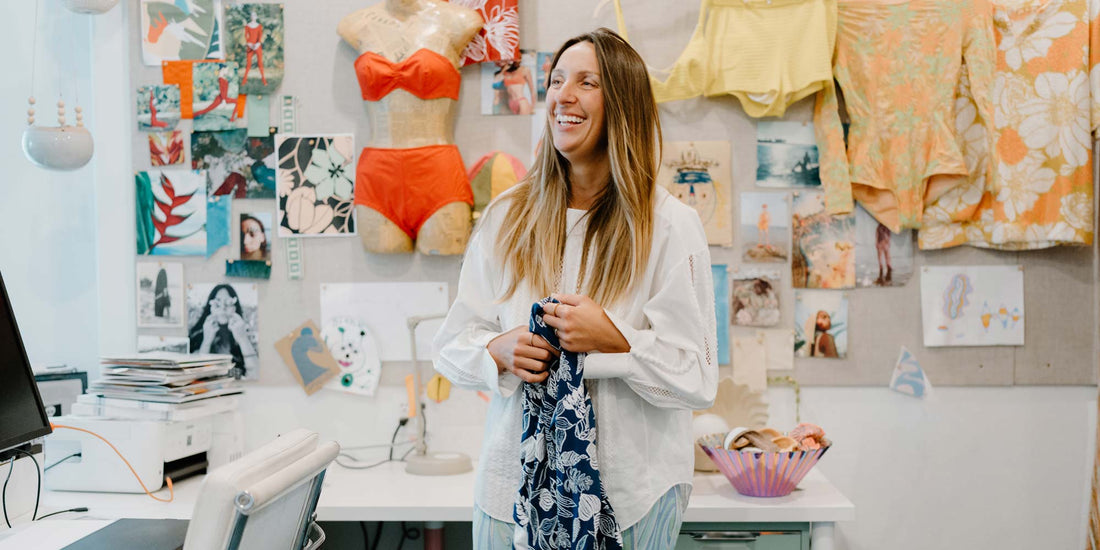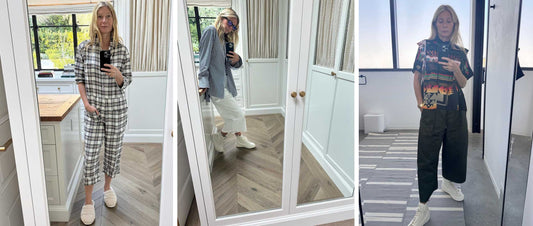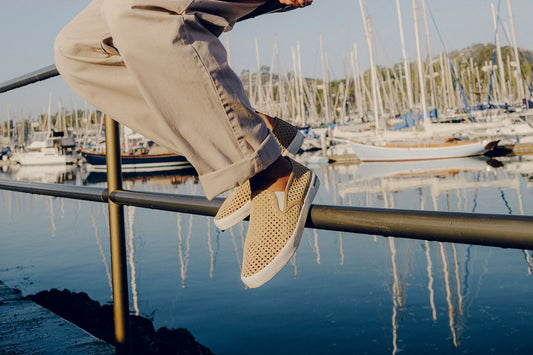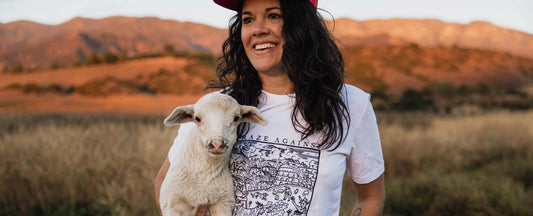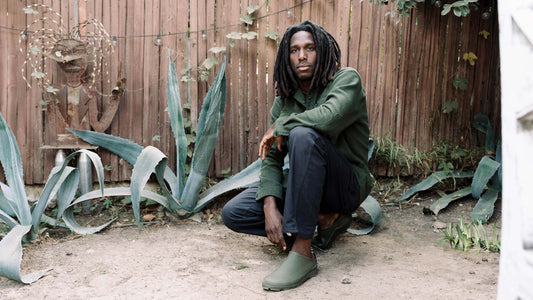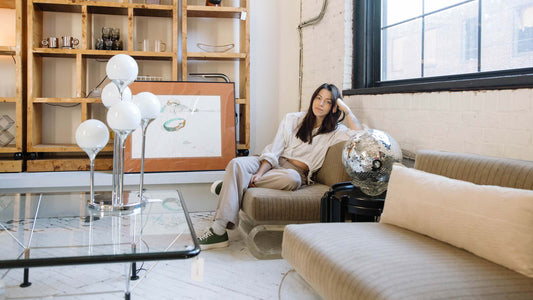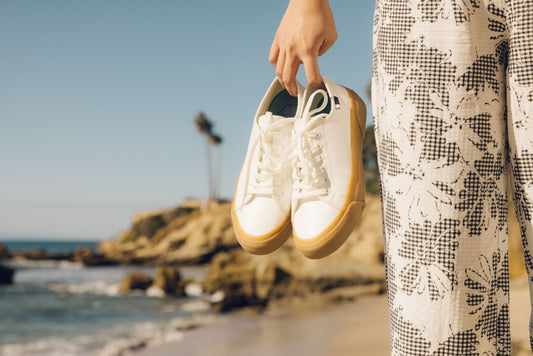When Amanda Chinchelli pronounces sea, “see-ah” (it's how she came up with the name for her brand), her accent skips and dances with the same femininity as the surfers she designs swimsuits for. She’s just arrived at her airy Orange County office and warehouse from a morning surf, and as she breezes through each corner — past a vintage seafoam-green fridge, a meeting area with mismatched chairs and a pink neon sign of her brand’s logo, a sewing room decorated with postcards and art — it’s clear the eclectic space is just an extension of Amanda herself: joyful, bright and busy.
Born in the tropics of Brazil, Amanda moved to her family's native Italy when she was ten and eventually made her way to coastal California, where she became frustrated with the availability of swimwear that complemented the classic style of surfing she loved. She launched Seea to offer female surfers comfortable, elegant suits inspired by vintage silhouettes but made from performance materials. Beyond her now-iconic designs, she’s creating a space to celebrate the culture of women’s longboarding, and a new dream for bringing more women together on the waves.
Words by Amanda Chinchelli, as told to SeaVees. Photos by Johnie Gall.

"I’d been in a long-distance relationship for six years with Brian when we broke up. Then he shows up in Florence out of the blue a few months later, gets down on one knee and asks me to marry him. I was in complete shock. It was so, so sweet, but told him I needed a few months to think about it. Then I said yes. I knew I couldn’t pass up the chance to be with him.
It was 2006 when I uprooted my life in Italy to move in with him in San Francisco. The creative, do-it-yourself energy of the city at the time was freaking mind-blowing — everyone was making music and having garage art shows. The energy seeped into me and I started having craft nights with my friends where we’d drink wine and sew together. I’m my truest self when I’m making things with my hands. My grandmother had taught me to sew and crochet, and when I got into snowboarding as a teen, I’d spend the drives to the mountain crocheting my own beanies. I hated the beanies they sold in stores at the time, all pointy and itchy with ugly seams. That’s been my philosophy my whole life: if I don’t like what’s out there, I’ll make it myself.


My passion for swimwear started in Brazil, where I was born. After we moved to Italy, we’d visit Brazil every year and that’s when I’d do my shopping because they just have the best, most high-quality swimwear. I was 14 years old when I took my first solo trip to visit family friends that were living on the coast of Sao Paulo, and that’s when I surfed for the first time. Sitting in the water, watching surfers glide through the waves around me, I was like, ‘What is this? I want to do this for the rest of my life!’
“That’s been my philosophy my whole life: if I don’t like what’s out there, I’ll make it myself.”
That feeling resurfaced when Brian and I visited San Onofre Beach in Southern California. There were all these classic cars and vintage outfits, it almost felt like a place frozen in time. But what truly captivated me was the classic, graceful style of the female longboarders there. It was such a beautiful thing to watch, like watching dancers. I thought, ‘Why is no one making suits for women that match the beauty of longboarding?’ I would literally surf in shorts and a big ugly T-shirt at the time because there were no good options. In my mind I saw the need, I saw the product, I saw the brand. I knew it needed to happen.

We’d stopped at this big thrift store on the drive down because thrifting is our favorite hobby. Sitting on the shelf was a serger, which is a sewing machine that allows you to sew knitwear. I’d always wanted one because it meant I could make a swimsuit. I made a few suits for myself and took them on a surf trip to Costa Rica. All my girlfriends were asking to borrow them and, with that reassurance, I came home and immediately got to work. The process was slow and I learned little-by-little. One friend taught me to make proper patterns, another took me to local factories. I taught myself design software and even how to type — we don’t learn that in school in Italy! I felt so ridiculous typing away with my two pointer fingers [laughs].
I made so many mistakes. So many! I had four designs and ordered 60 pieces each and they were due to arrive in July. They arrived in October. Summer was over, and I figured I was totally screwed. But, I got in my car and I went to each of the boutique surf shops I could think of to try and sell them. The buyers were all men, but almost immediately they saw how unique the suits were and bought them on consignment. Those sold, and so the shops ordered more.


Around this time, Brian came with me on one of my roadtrips — when he saw the reaction of the buyers, he was blown away. He took on sales and we started buying more stock. In the early days, we shipped everything from the house. We’d letterpress the hangtags and attach them to the suits with elastic hair ties (because you always need one of those when you’re surfing). Friends would come over to drink beer and help us prepare orders.
"I always knew I was on the right track because of the reassurance I got from the women wearing the suits.”
We ended up winning two major awards from SIMA (Surf Industry Manufacturers Association): Women’s Swimwear Brand of the Year and Breakout Brand of the Year. It felt really good to get recognition from an industry that is so male-dominated.

I have never doubted the vision for Seea. I always knew I was on the right track because of the reassurance I got from women wearing the suits. They’d tell me they surf better in my suits because they felt so good in them, they had better posture, they were more comfortable. When we shot our first video at San Onofre, it was this beautiful encapsulation of the brand itself. It wasn’t about getting more waves or being as good as the guys. It was about being out in the water, together with women.
My motivation now comes from how things are made. Making things right in a less impactful way, finding methods to cut waste (like using leftover materials for surfboard covers), and partnering with factories to do a better job. That gives me a lot of fire. And I need that fire because running a small business is hard — really hard. The hard part for me now is stopping myself from designing too much — let’s just say inspiration has never been the issue!
Maybe some investor will come in here carrying big bags of cash, but I’m not going to work with someone who tells me to just make more product. That would destroy the brand. We're at a turning point in our story after 10 years and need to decide our path forward. We will grow not by making more stuff, but by making our stuff better.


That’s my new dream. That and buying some land to park all of our VW vans on and create a little Seea compound — we’d have an office there and women can come work for the summer, take the vans out to camp and surf in our suits. I miss the interaction with my customers, and I want to make Seea an experience for them. The thing is, I didn’t make Seea just to make a product. I made it to celebrate the culture of female longboarders and all types of water women. The surf industry focuses so heavily on big, flashy contests and aggressive styles of surfing. It’s so male dominated. I wanted to show the world the beauty of what these women were doing together out in the water, to create a space where I could help amplify this counter-culture. Seea has never just been about making suits — it’s about community.
"I start dreaming and it grows, and it becomes something I have to do.”
For now, we’re starting a little surf-and-knit summer circle at the beach this summer. Women can come get together every Friday, bring beach chairs and towels and we’ll sit in the grass and crochet, take turns watching each other’s kids if the mamas want to go surfing. What a full-circle moment, right? This is just how my mind works. I start dreaming and it grows, and it becomes something I have to do."
Amanda is wearing the SeaChange LTT in vegan corn leather. Every pair of shoes sold from our SeaChange collection gives back $1 to our partner SeaTrees, a nonprofit that works to restore blue carbon coastal ecosystems and ocean health globally.

